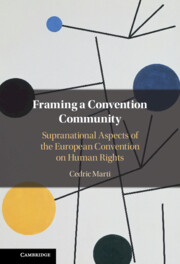Book contents
- Framing a Convention Community
- Framing a Convention Community
- Copyright page
- Dedication
- Contents
- Preface and Acknowledgments
- Table of Cases
- Table of International Instruments
- Abbreviations
- Introduction
- 1 Supranationality
- 2 Rediscovering Supranationality
- 3 From International toward Supranational Adjudication
- 4 Sites of Judicial Integration and Their Transformation
- 5 Supranational Lawmaking
- 6 From Supranational Adjudication to Supranational Law?
- Conclusion Framing a Convention Community
- Bibliography
- Index
4 - Sites of Judicial Integration and Their Transformation
Published online by Cambridge University Press: 12 November 2021
- Framing a Convention Community
- Framing a Convention Community
- Copyright page
- Dedication
- Contents
- Preface and Acknowledgments
- Table of Cases
- Table of International Instruments
- Abbreviations
- Introduction
- 1 Supranationality
- 2 Rediscovering Supranationality
- 3 From International toward Supranational Adjudication
- 4 Sites of Judicial Integration and Their Transformation
- 5 Supranational Lawmaking
- 6 From Supranational Adjudication to Supranational Law?
- Conclusion Framing a Convention Community
- Bibliography
- Index
Summary
This chapter examines the ECtHR’s supranational authority in detail analyzing the Court’s classical function of providing judicial review, its remedial practice as well as the new advisory jurisdiction as introduced by Protocol 16. Acknowledging that the ECHR system cannot be connected to a larger autonomous political unit, the claim is put forward is that the ECtHR nonetheless provides for a complementary layer of public authority which directly operates on individuals alongside that of domestic legal systems. The ECtHR enjoys a broad measure of autonomy over states and may circumvent the state veil by placing individuals under international protection or responsibilizing domestic authorities. The direct interaction with domestic actors not only represents part of the Court’s supranational authority but informs, at the same time, its legitimacy as the Convention community feeds on domestic actors, individuals especially, directly submitting their arguments to the Court.
Keywords
- Type
- Chapter
- Information
- Framing a Convention CommunitySupranational Aspects of the European Convention on Human Rights, pp. 85 - 131Publisher: Cambridge University PressPrint publication year: 2021

